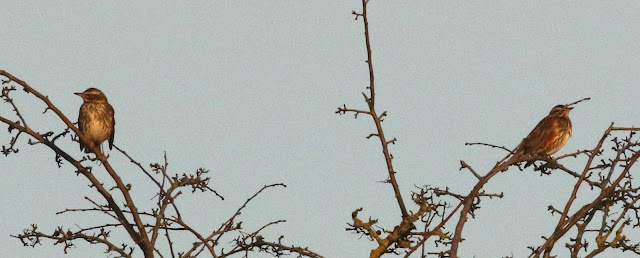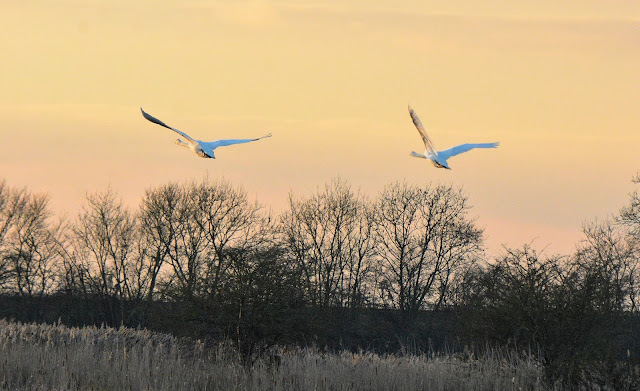Male Bearded Tit
On Tuesday the classes started again at East Park. Gales had been forecast, but luckily they didn’t materialise. However, it was very overcast, so we had to really peer through the gloom at times. It was difficult to pick out colour on some of the smallest birds.
We started near the main gates, and although there was the sound of a distant Mistle Thrush it couldn’t be seen. After all the rain at the end of last year there seemed to be a general lack of wildfowl on the grass. The Black-headed and Common Gulls were still present.
Black-headed Gulls [1st winter left]
When we reached the lake we saw our first ducks, including some timid Tufted Ducks. We had to reach the water overlooking the boathouse before we saw many of the Goosanders. A Cormorant was drying its wings. As we continued a Great Spotted Woodpecker was heard calling, and then a female was seen high in a sycamore. When we walked round to the splashboat we saw at least 3 male Pochard among the other ducks.
After the lavatories had been left behind we reached the main lake. We did a circumnavigation of the lake and reached the back of the final island. Margaret spotted a young Heron almost completely concealed by Willow twigs. On the boardwalk just above the water a Kingfisher was seen, which flew across the water to the back of the second island. We continued round when someone spotted two Great Crested Grebes, which soon began to make some angry grunting sounds. We witnessed the Grebes forcing a Coot off their planned nest site.
Immature Heron
"Perry"
Common Gull
We found three Goldcrests in the sunken garden area, but it started to rain, and we made for the car parking area. We were almost back when Gill spotted a Treecreeper, soon another one was also seen
Gill's Treecreeper
On Wednesday I had planned for us to be at Tophill, but this was still closed after the 2019 heavy rain, so we went to Sewerby instead. There was a Song Thrush singing when we first arrived, but it soon went silent.
We walked down the steep steps to the beach, and were surprised to find around 8 Great Crested Grebes on the sea. Also present were Turnstones, Oystercatchers, a Redshank, plus Black-headed, Common, Herring and Great Black backed Gulls. We were about to go when a Pipit flew below us and disappeared into some of the piles of soil under the cliffs. Eventually, it came out into the open, so everyone got a view of a Rock Pipit, before it returned from whence it came.
Great Spotted Woodpecker (c) 2020 Aileen Urquhart
Oystercatcher
ditto
Rock Pipit
Rock Pipit (c) 2020 Tony Robinson
Immature Gull
Record shot of Great Crested Grebes
Record shot of Red-throated Diver
Record shot of Goldcrest (c) 2020 Aileen Urquhart
The woodland areas were rather quiet, but we eventually saw Chaffinches, Goldfinches, a couple of Greenfinches and two pairs of Bullfinches. Behind the zoo Tony found a Goldcrest, which seems to want to display its crest most of the time. Another one joined it briefly. We were almost back at the cars when two pairs of Song Thrushes were observed among the leaf litter and the opening Winter Aconites.
Song Thrush
Sika Deer
Winter Aconites
Some of the Wednesday am group went on to the lighthouse area looking for Snow Buntings and Lapland buntings. They had distant views of those, but better sightings of a Stonechat and a Short-eared Owl.
Stonechat (c) 2020 Tony Robinson
Short-eared Owl (c) 2020 Tony Robinson
ditto
ditto
ditto
On Thursday we revisited East Park, so many of the species seen were the same as on Tuesday morning. However, the light was much better at first, so the photo opportunities were greater. It did cloud over towards the end of the morning though.
Female Chaffinch - note green rump
Little Grebes
ditto
Drake Pochard
Female Goosander
Drake Goosander
Goldcrest
ditto
Rose's Treecreeper
On Friday we crossed the Humber for our first visit of the year to Ness End. The light was perfect, but there was a cooler wind than we’d known so far this year. At first it was rather quiet apart from 3 female Goldeneye. We were just about to go when I spotted the Bittern down the right-hand channel near the reeds at the fringe. It was sky-pointing at first, but soon brought its bill down and looked hunched. A few minutes later it pointed into the sky again before launching itself across the lake, then it disappeared into the reeds on the opposite side.
Bittern
ditto
Take-Off
Up
We set off on the periphery path and we were looking across an area that had been cleared fairly recently when I heard to distinctive pinging of some Bearded Tits. As we stood watching a pair came closer and closer until the male was perfectly lit by the sun.
Bearded Tit
ditto
ditto
ditto
ditto
On Target Lake we had GC Grebe, Little Grebe, 2 Snipe, and some marvellously lit Shoveler. A single Teal was on the bank. In the afternoon only the Little Grebe and Shoveler remained.
Great Crested Grebe
Little Grebe
Mute Swans
Long-tailed Tit
Shoveler
From Ness End hide in which the sun was almost too bright we saw a very hidden Cetti’s Warbler, plus a Bullfinch and a Treecreeper. We could hear a Water Rail, but it remained concealed in the reedbed. In the afternoon most of these had gone, but two white-bearded gents were staring straight out of the hide when we arrived. It took Chris to point out that there was a Bittern just a few feet away, giving what has been called crippling views.
Goldeneye
ditto
Goldeneye (c) 2020 Mike Woods
ditto
ditto
Kestrel
ditto
Kestrel (c) 2020 Mike Woods
Redwings
Redwing
ditto
Record shot of Redwing (c) 2020 Mike Woods
Gadwall
Gadwall (c) 2020 Mike Woods
Marsh Harrier
ditto
ditto
ditto
Marsh Harrier (c) 2020 Mike Woods
Harrier v. Crow (c) 2020 Mike Woods
Cormorants
Cormorants (c) 2020 Mike Woods
Chris's Bittern
Bittern
ditto
ditto
Bittern (c) 2020 Mike Woods
ditto
gulp (c) 2020 Mike Woods
close-up (c) 2020 Mike Woods
Winter Heliotrope
Mute Swans (c) 2020 Mike Woods
Mistle Thrush (c) 2020 Mike Woods
Sunset (c) 2020 Mike Woods






















































































1 comment:
Great photos. The Butterbur photo in fact is its close relative Winter Heliotrope. You won't find Butterbur flowering this early. Winter Heliotrope is widely naturalised & can be quite invasive.
Post a Comment